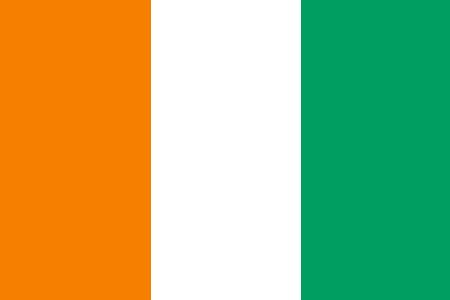Region Sub-Sahara Coastline 590 km (370 mi) Continent Africa | Coordinates 8°0'N, 500'W Area 322,463 km² | |
 | ||
Borders Total land borders:3,458 km (2,149 mi)Liberia: 778 km (483 mi)Ghana: 720 km (450 mi)Guinea: 816 km (507 mi)Burkina Faso: 545 km (339 mi)Mali: 599 km (372 mi) Highest point Mont Nimba1,752 m (5,748 ft) Neighboring countries | ||
Ivory Coast (Côte d'Ivoire) is a sub-Saharan nation in southern West Africa located at 8 00°N, 5 00°W. The country is approximately square in shape. Its southern border is a 515 km (320 mi) coastline on the Gulf of Guinea on the north Atlantic Ocean. On the other three sides it borders five other African nations for a total of 3,458 km (2,149 mi): Liberia to the southwest for 778 km (483 mi), Guinea to the northwest for 816 km (507 mi), Mali to the north-northwest for 599 km (372 mi), Burkina Faso to the north-northeast for 545 km (339 mi), and Ghana to the east for 720 km (447 mi).
Contents
- Map of The Ivory Coast
- Maritime claims
- Terrain and topography
- Rivers
- Climate
- Natural hazards
- Extreme points
- References
Map of The Ivory Coast
Ivory Coast comprises 322,463 km2 (124,500 sq mi), of which 318,003 km2 (122,780 sq mi) is land and 4,460 km2 (1,720 sq mi) is water, which makes the country about the size of Germany.
Maritime claims
Ivory Coast makes maritime claims of 200 nautical miles (370.4 km; 230.2 mi) as an exclusive economic zone, 12 nautical miles (22.2 km; 13.8 mi) of territorial sea, and a 200 nautical miles (370.4 km; 230.2 mi) continental shelf.
Terrain and topography
Ivory Coast's terrain can generally be described as a large plateau rising gradually from sea level in the south to almost 500 m (1,640 ft) elevation in the north. The nation's natural resources have made it into a comparatively prosperous nation in the African economy. The southeastern region of Ivory Coast is marked by coastal inland lagoons that starts at the Ghanaian border and stretch 300 km (186 mi) along the eastern half of the coast. The southern region, especially the southwest, is covered with dense tropical moist forest. The Eastern Guinean forests extend from the Sassandra River across the south-central and southeast portion of Ivory Coast and east into Ghana, while the Western Guinean lowland forests extend west from the Sassandra River into Liberia and southeastern Guinea. The mountains of Dix-Huit Montagnes region, in the west of the country near the border with Guinea and Liberia, are home to the Guinean montane forests.
The Guinean forest-savanna mosaic belt extends across the middle of the country from east to west, and is the transition zone between the coastal forests and the interior savannas. The forest-savanna mosaic interlaces forest, savanna and grassland habitats. Northern Ivory Coast is part of the West Sudanian Savanna ecoregion of the Tropical and subtropical grasslands, savannas, and shrublands biome. It is a zone of lateritic or sandy soils, with vegetation decreasing from south to north.
The terrain is mostly flat to undulating plain, with mountains in the northwest. The lowest elevation in Ivory Coast is at sea level on the coasts. The highest elevation is Mount Nimba, at 1,752 metres (5,748 ft) in the far west of the country along the border with Guinea and Liberia.
Rivers
The Cavalla River drains the western border area of the Ivory Coast and eastern Liberia. It forms the southern two-thirds of the international boundary between Liberia and Côte d'Ivoire.
The Sassandra River forms in the Guinea highlands and drains much of the western part of the Ivory Coast east of the Cavalla River.
The Bandama River is the longest river in the Ivory Coast with a length of some 800 km (497 mi) draining the east central part of the country. In 1973 the Kossou Dam was constructed at Kossou on the Bandama creating Lake Kossou. The capital, Yamoussoukro, is located near the river south of the lake.
The Komoé River originates on the Sikasso Plateau of Burkina Faso, and briefly follows the border between Burkina Faso and Ivory Coast before entering Ivory Coast. It drains the northeastern and eastern-most portions of the country before emptying into the eastern end of the Ébrié Lagoon and ultimately the Gulf of Guinea in the Atlantic Ocean. Its waters contribute to the Comoé National Park.
Climate
The climate of Ivory Coast is generally warm and humid, ranging from equatorial in the southern coasts to tropical in the middle and semiarid in the far north. There are three seasons: warm and dry (November to March), hot and dry (March to May), and hot and wet (June to October). Temperatures average between 25 and 32 °C (77.0 and 89.6 °F) and range from 10 to 40 °C (50 to 104 °F).
Natural hazards
Natural hazards include the heavy surf and the lack of natural harbors on the coast; during the rainy season torrential flooding is a danger.
Extreme points
Extreme points are the geographic points that are farther north, south, east or west than any other location in the country.
